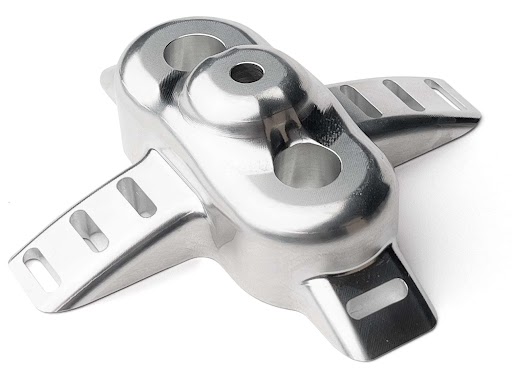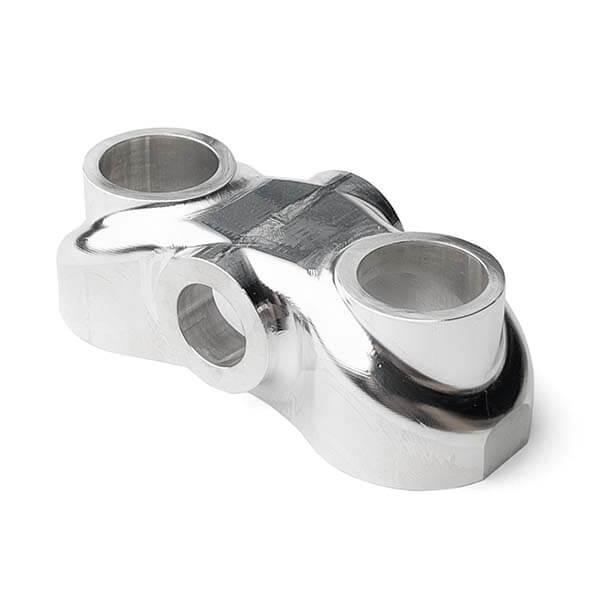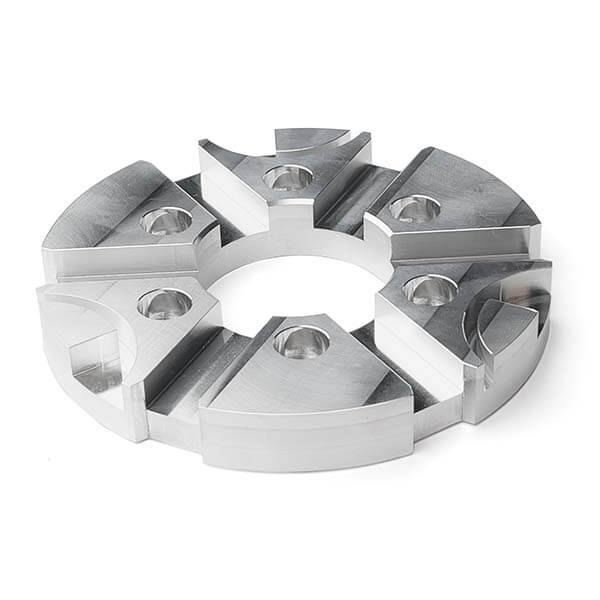Aluminium 2033
Developed to comply with new environmental regulations, this lead-free alloy combines excellent machinability, high mechanical strength and significantly improved anodising capacity, making the anodising process much easier.

PROS
- Excellent Machinability
- Excellent anodising capability
- RoHS II, ELV and REACH compliant
- High mechanical properties
CONS
- Limited marine corrosion resistance
- Not recommended for MIG, TIG and brazing welding
MAIN FEATURES
- Machining process: CNC Machining
- Tolerances: ISO 2768-1 fine (f) or medium (m) class. Info
- Max size: 150x150x500 mm; 5.9x5.9x19.7 in
- Lead time: <4 days
Aluminium 2033 CNC machined VIDEO GALLERY
Compliant with regulations
Lead-free aluminium alloy 2033 is designed to strictly comply with the latest environmental regulations, such as RoHS II, ELV and REACH. These regulations limit the use of hazardous substances, such as lead, to a maximum of 0.1%, making Alloy 2033 a safe and sustainable choice. Thanks to its compliance, this alloy is ideal for companies wishing to reduce their environmental impact and ensure the safety of their products.
Excellent machinability
This aluminium is renowned for its excellent machinability, particularly suitable for high-speed machining. The alloy produces very fine chips, reducing tool wear and improving the efficiency of production processes. This level of machinability allows for high-precision parts with tight tolerances, making alloy 2033 ideal for complex and critical applications in various industries.
Excellent anodising capacity
One of the distinctive features of aluminium 2033 lead free is its greatly improved anodising capability. This process is much easier and more effective than other 2000 series alloys, allowing for uniform, corrosion-resistant surface finishes. The ease of anodising makes this alloy particularly suitable for applications requiring additional protection and a superior aesthetic appearance, such as in the electronics and automotive industries.
IMAGE GALLERY
QUOTE NOW YOUR ALUMINIUM 2033 LEAD-FREE PARTS
free instant quoteCOMMENT
Lead-free aluminium alloy 2033 represents one of the most significant innovations in the field of aluminium alloys for high-speed machining. Developed to meet new environmental regulations, this alloy offers a combination of excellent machinability, high mechanical strength and improved anodising capabilities compared to traditional alloys such as 2011, 2007, and 2030.
Pros
Compliance with Regulations: The lead-free 2033 complies with the RoHS II, ELV and REACH directives. The RoHS directive (2018/740/EU) limits the concentration of lead in aluminium alloys to a maximum of 0.1 per cent from 18 May 2021. Similarly, REACH has classified lead as a substance of very high concern (SVHC), requiring specific authorisations for concentrations above 0.1%. Alloy 2033 was developed in response to these regulations, eliminating lead and thus improving safety and environmental sustainability.
Excellent Machinability: Developed specifically for high-speed automatic lathes, the alloy produces very fine chips, increasing tool life and improving machining efficiency.
High Mechanical Properties: It offers a typical tensile strength (Rm) of 370 MPa, a yield strength (Rp0.2) of 240-270 MPa and a Brinell hardness (HBW) of 95.
Anodising and Weldability: Better aptitude for protective and decorative anodising as well as resistance welding than conventional 2000 series alloys.
Cons
Limited marine corrosion resistance: A significant disadvantage of Aluminium alloy 2033 is its poor resistance to corrosion, particularly marine corrosion. This makes this alloy less suitable for applications where contact with corrosive agents such as water or chemicals is frequent. It is important to consider this limitation when choosing this alloy for a specific application.
Not recommended for welding: This alloy is not recommended for MIG (Metal Inert Gas) and TIG (Tungsten Inert Gas) welding, as well as brazing. The chemical structure and physical properties of Alloy 2033 do not favour these joining methods, resulting in sub-optimal performance and possible structural integrity problems in welded joints. Therefore, for applications requiring MIG, TIG welding or brazing, it is preferable to consider other aluminium alloys better suited to these processes.
Composition of aluminium 2033
The chemical composition of Alloy 2033 is carefully balanced to optimise its physical and mechanical properties. The main elements include:
-
Silicon (Si): 0,10 - 1,20%
-
Iron (Fe): ≤ 0,70%
-
Copper (Cu): 2,20 - 2,70%
-
Manganese (Mn): 0,40 - 1,00%
-
Magnesium (Mg): 0,20 - 0,60%
-
Bismuth (Bi): 0,05 - 0,80%
-
Zinc (Zn), Titanium (Ti), and others: Traces up to a total of 0.15%.
Comparison to other materials
2033 VS 2011: 2011 alloy is known for its excellent machinability and is often used for high-speed machining and the production of complex parts. However, it contains a significant percentage of lead (Pb), which makes it non-compliant with the recent RoHS and REACH regulations limiting lead content to 0.1%. Alloy 2033 offers machinability comparable to 2011 despite the absence of lead.
2033 VS 2007: Alloy 2007 is another aluminium alloy known for its good machinability and is used in applications similar to 2011. However, this alloy also contains lead, which makes it subject to the same regulatory restrictions. 2033 outperforms 2007 in terms of machinability due to its ability to produce very fine chips, facilitating operations on high-speed automatic lathes. In addition, 2033 offers better aptitude for anodising and welding than 2007, making it more versatile for various applications.
2033 VS 2030: Alloy 2030 is similar to 2011 and 2007 in terms of machinability and use, but it too contains lead, limiting its use in accordance with new regulations. Alloy 2033 maintains excellent machinability, which improves the efficiency of production processes. Being lead-free, 2033 is fully compliant with the RoHS and REACH directives, making it a safer choice than 2030. The 2033 not only offers better mechanical properties but also better weldability and strength than the 2030.
Common and recommended uses
Thanks to its superior properties, lead-free Alloy 2033 is ideal for a wide range of applications, including:
Automotive industry: In the automotive industry, alloy 2033 LEAD FREE is used for critical components that require high precision and strength. These include elements such as engine parts, transmission systems, connectors and other structural components. Its high machinability and mechanical strength enable the production of complex parts with very tight tolerances, improving the overall quality and reliability of vehicles.
Electrical and Electronics Industry: Alloy 2033 is ideal for parts requiring excellent conductivity and reliability, such as electrical connectors, printed circuit board components and heat sinks. Its ability to be easily anodised and welded makes it suitable for applications requiring corrosion protection and good heat conduction.
Defence and Aerospace: The resistance to extreme conditions makes Alloy 2033 suitable for defence and aerospace applications. It is used to produce parts that must withstand high mechanical stress and harsh environmental conditions, such as components for aircraft, missiles and other military applications. The ability to resist atmospheric and marine corrosion is particularly useful in these sectors.
Stamping and Fasteners: For the production of screws, bolts, nuts and other threaded parts with limited thicknesses, alloy 2033 LEAD FREE is an excellent choice. Its high machinability allows the production of precision parts with tight tolerances, essential for the reliable operation of mechanical assemblies. The production of very fine chips improves machining efficiency and reduces tool wear.
Conclusion
Lead-free aluminium alloy 2033 represents a state-of-the-art solution for machining, combining high machinability, environmental safety and superior mechanical properties. Thanks to its compliance with international standards and outstanding technical characteristics, this alloy is the ideal choice for modern industries seeking efficiency and sustainability.
"We were extremely satisfied with our experience with the aluminium 2033 supplied and CNC-machined by Weerg. From the beginning, communication with the Weerg team was clear and professional, demonstrating a deep understanding of the material and its applications. The quality of the CNC machining was excellent: the parts had very tight tolerances and a flawless surface finish, essential for our quality standards."
ALUMINIUM 2033 PROPERTIES
| Tensile breaking load | 340-370 MPa |
| Modulus of elasticity | 70 GPa |
| Elongation at break | 5-8% |
| Density | 2,77 g/cm³ |
| Melting temperature | |
| Hardness | 95 Brinell |
| Yield strength | 220-270 MPa |
QUOTE IN 1 SECOND WITHOUT COMMITMENT
DON'T WAIT: UPLOAD YOUR 3D FILE AND GET A QUOTE FOR YOUR PARTS NOW!
Upload your 3D file to get one step closer to manufacturing your parts.
free instant quote



